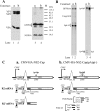The abundant R2 mRNA generated by aleutian mink disease parvovirus is tricistronic, encoding NS2, VP1, and VP2
- PMID: 17428872
- PMCID: PMC1933312
- DOI: 10.1128/JVI.00244-07
The abundant R2 mRNA generated by aleutian mink disease parvovirus is tricistronic, encoding NS2, VP1, and VP2
Abstract
The abundant R2 mRNA encoded by the single left-end promoter of Aleutian mink disease parvovirus is tricistronic; it not only expresses the capsid proteins VP1 and VP2 but is also the major source for the nonstructural protein NS2. A cis-acting sequence within the NS2 gene was shown to be required for efficient capsid protein production, and its effect displayed a distinct location dependence. Ribosome transit through the upstream NS2 gene region was necessary for efficient VP1 and VP2 expression; however, neither ablation nor improvement of the NS2 initiating AUG had an effect on capsid protein production, suggesting that the translation of the NS2 protein per se had little influence on VP1 and VP2 expression. Thus, proper control of the alternative translation of the tricistronic R2 mRNA, a process critical for viral replication, is governed in a complex manner.
Figures






Similar articles
-
The transcription profile of Aleutian mink disease virus in CRFK cells is generated by alternative processing of pre-mRNAs produced from a single promoter.J Virol. 2006 Jan;80(2):654-62. doi: 10.1128/JVI.80.2.654-662.2006. J Virol. 2006. PMID: 16378968 Free PMC article.
-
Comparison of promoter activity in Aleutian mink disease parvovirus, minute virus of mice, and canine parvovirus: possible role of weak promoters in the pathogenesis of Aleutian mink disease parvovirus infection.J Virol. 1993 Apr;67(4):1877-86. doi: 10.1128/JVI.67.4.1877-1886.1993. J Virol. 1993. PMID: 8383215 Free PMC article.
-
Internal polyadenylation of parvoviral precursor mRNA limits progeny virus production.Virology. 2012 May 10;426(2):167-77. doi: 10.1016/j.virol.2012.01.031. Epub 2012 Feb 21. Virology. 2012. PMID: 22361476 Free PMC article.
-
Pathogenesis of aleutian mink disease parvovirus and similarities to b19 infection.J Vet Med B Infect Dis Vet Public Health. 2005 Sep-Oct;52(7-8):331-4. doi: 10.1111/j.1439-0450.2005.00864.x. J Vet Med B Infect Dis Vet Public Health. 2005. PMID: 16316395 Review.
-
Mechanisms contributing to the virus persistence in Aleutian disease.Dtsch Tierarztl Wochenschr. 1990 Feb;97(2):96-9. Dtsch Tierarztl Wochenschr. 1990. PMID: 2155772 Review.
Cited by
-
The 5' Untranslated Region of the Capsid Protein 2 Gene of Mink Enteritis Virus Is Essential for Its Expression.J Virol. 2018 Aug 29;92(18):e00787-18. doi: 10.1128/JVI.00787-18. Print 2018 Sep 15. J Virol. 2018. PMID: 29976664 Free PMC article.
-
The 5' Untranslated Region of Human Bocavirus Capsid Transcripts Regulates Viral mRNA Biogenesis and Alternative Translation.J Virol. 2018 Oct 12;92(21):e00443-18. doi: 10.1128/JVI.00443-18. Print 2018 Nov 1. J Virol. 2018. PMID: 30111560 Free PMC article.
-
Molecular characterization of the small nonstructural proteins of parvovirus Aleutian mink disease virus (AMDV) during infection.Virology. 2014 Mar;452-453:23-31. doi: 10.1016/j.virol.2014.01.005. Epub 2014 Jan 28. Virology. 2014. PMID: 24606679 Free PMC article.
-
Hybrid DNA virus in Chinese patients with seronegative hepatitis discovered by deep sequencing.Proc Natl Acad Sci U S A. 2013 Jun 18;110(25):10264-9. doi: 10.1073/pnas.1303744110. Epub 2013 May 28. Proc Natl Acad Sci U S A. 2013. PMID: 23716702 Free PMC article.
-
Adeno-associated virus type 5 utilizes alternative translation initiation to encode a small Rep40-like protein.J Virol. 2010 Jan;84(2):1193-7. doi: 10.1128/JVI.01961-09. Epub 2009 Nov 4. J Virol. 2010. PMID: 19889770 Free PMC article.
References
-
- Alexandersen, S. 1986. Acute interstitial pneumonia in mink kits: experimental reproduction of the disease. Vet. Pathol. 23:579-588. - PubMed
-
- Alexandersen, S., M. E. Bloom, J. Wolfinbarger, and R. E. Race. 1987. In situ molecular hybridization for detection of Aleutian mink disease parvovirus DNA by using strand-specific probes: identification of target cells for viral replication in cell cultures and in mink kits with virus-induced interstitial pneumonia. J. Virol. 61:2407-2419. - PMC - PubMed
-
- Alexandersen, S., A. Uttenthal-Jensen, and B. Aasted. 1986. Demonstration of non-degraded Aleutian disease virus (ADV) proteins in lung tissue from experimentally infected mink kits. Arch. Virol. 87:127-133. - PubMed
Publication types
MeSH terms
Substances
Grants and funding
LinkOut - more resources
Full Text Sources

